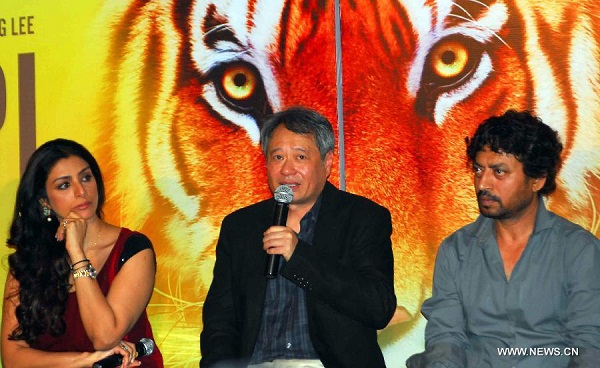Ang Lee on Life of Pi, India and more!
November 2, 2012In conversation with Mansha Rastogi.
It may just be a first of sorts that India is taking the center seat in a multi-million Hollywood project. Life Of Pi is indeed changing the trends in many a ways. The international promotions of the film kick start from India and the film releases first in India and then across the globe. We caught up with the Academy Awards winner film maker Ang Lee while on his tour to India for the promotions of his much anticipated film Life Of Pi.
Until now it’s only the darker side that’s attracted attention from the West. You may just be the first one to glorify Indian culture. Do you think it will grab eyeballs?
I think either ways it is unfair (to show darker side or glorifying India) as Indians are in middle. It’s your home. Whenever outsiders come they take what they need. Like Yann Martel; he romanticized India. It wasn’t the real India he showed. Nobody owns a zoo, not even Michael Jackson. Even in Pondicherry before the ’70s, there were hardly any nuclear families. Lot of that isn’t realistic. It’s a fable like thing. I tried to justify it so that people here don’t raise eye brows. It’s not always fair, you need a whole spectrum to show the Indian lives.
This probably would be the first time that your film is getting a massive release in India. What kind of a response or reception did you think you would receive before coming to India?
I am full of anxiety. I hope culturally when you see the first half people don’t raise their eye brows. I have done my best. I roped in Indian consultants, Indian cast and crew and tried to make this film as realistic as possible. The best part about Pi’s character is that he isn’t a bullshitter. Everything he says in the book is somewhat realistic and you cannot prove he is wrong. So that’s the charm of the book. I hope the Indian audience doesn’t find it unauthentic. I hope Indian audience gets a thrill while watching the movie. It’s based in a specific time and place, it’s based in Pondicherry which is anyway unlike all of India too.
A lot of money has been put in the movie. What are your expectations from the Indian market?
I hope my film goes big. Most of all I hope that the movie is thought inspiring. I want people to generate wonderful thoughts towards life after watching the movie. India is a very spiritual place. Not only the Indian critics but I am very curious to see how the general audience reacts to the film.
At what stage of reading this novel did you decide to make the film?
I read the book when it first came in 2001. Around five years ago, Fox Star Studios approached me to direct it. I immediately got hooked and I knew it was a huge responsibility.
It’s a very tough book to be adapted in be made in a film. How did you visualise the film?
I took up the challenge in two stages. The first thing I did was I came to India and followed the route that Yann Martel has written in the book. Along with my researcher and screenplay writer we did a lot of research. This was just the Indian part of the book. I shot in India at Pondicherry and Munnar.
The other important element was the ocean. I spent about a year doing pre visualisation. I converted all my ideas into a virtual set on a computer. It was very helpful. It gave me a great perspective and I could modify whatever I could. We had to build a wave tank to simulate open Ocean. I build a studio at Tai Chong airport which is third largest city in Taiwan. We used terminals as offices and hangars as studios.
You have taken 3D on a different level with “Life of Pi”. Give us an insight into the making the film in 3D?
Making the film in 3D started off as a very naive and stupid idea. I thought it was impossible to make this film in 3D. The 3D technology is very expensive. When you read the book you will find that it is very spiritual. I thought that if I can add another dimension to the movie (3D) maybe I could take a leap of faith (Laughs). I didn’t want 3D to be just a gimmick in my movie. When I shot some of the ocean part in 3D, I realised that it was a new illusion which was quite fascinating.
It took you almost eight months to say yes to a project. Did you at any point during that time think of backing off?
A couple of times. Not from me, but from the Studio. They thought it was too expensive. But for me starting something and not finishing it is like killing me. So once I get hooked I am possessed. I just don’t want to take No for an answer. I had to provide evidence whether a certain thing was doable. My thoughts and tests on 3D, pre-visualisation etc. in every meeting I had to show them how I wanted to go about it. They found my decision to go to Taiwan crazy but I did a tour with the producers and went step by step. Then I started my auditions. I had to show them the tape of Suraj, who plays the main lead. Little by little they gave in. Right before they gave a green light to my film, thank God, they had a big flop in their regular formula movie. It was a big summer Hollywood movie and it turned out to be a big flop, nobody went to see it. I cannot tell you what movie was that but the same week we got a green light.
How much is a film about technique and how much is it about story for you? Life Of Pi is after all a philosophical novel. How did you bring about the balance?
Whenever people watch a film they go for an emotional ride. The film should serve their purpose as artistic tools. It’s a very expensive art. Thousands of people work with you, millions of dollars are spent. You have to plan almost everything in advance, pre-visualise it. I wasn’t trained that way. I had to force myself and try myself. I used to block out the shots work out the emotions before I decided to shoot it. I cannot do that. Because when I shot Suraj, the tiger wasn’t there. He was only to be graphically incorporated a year later.
Do you think the excess emphasis on emotional quotient is our contribution to the West?
Yes. I think they are pretty dried up. They have been dominated by the western culture of Europe and America for so long, its time Asians offered something. I think in the movie business they always look for something fresh they also look for something universal. That’s how the mainstream movies are. For people who want to go mainstream in Hollywood film making they have to go beyond specific, they have to find something universal that moves everybody.
How much are you exposed to Indian movies?
Not much. I remember about 10-15 years ago when I saw Sholay I thought in American movies everything is very faster. The focus is only on the story. But India can give four hours of everything.
As you mentioned the film was a big undertaking. Three other filmmakers who were approached before backed off. What went through your mind before signing this up?
They all backed off for different reasons. Two never got into the project, Shyamalan never read the script. I don’t know what’s the story of the second director, but the previous one went pretty deep. He animated the movie too. But the studio and him never got along and somehow they fell apart. Then came me. I came with the perception that every movie has its own fate. When I start a film I develop a sense of belonging , I belong to the movie and the movie is mine. Then there’s no use of thinking about the previous history.
How much of your own interpretation did you bring in the story?
Everything is my interpretation. We are filmmakers, not translators. We don’t convert books from words to cinema. It’s what moves us or inspires us that we try to spell out cinematically. I hope the film stands on its own even though it is from the book because it’s a different media.
We welcome your comments at letters@friedeye.com




